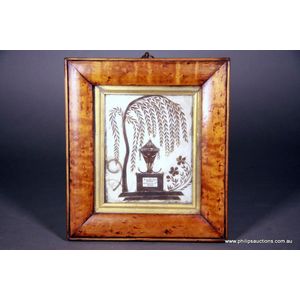Mourning Picture for Anne Probert
You must be a subscriber, and be logged in to view price and dealer details.
Subscribe Now to view actual auction price for this item
When you subscribe, you have the option of setting the currency in which to display prices to $Au, $US, $NZ or Stg.
- Victorian Period - The Victorian period of furniture and decorative arts design covers the reign of Queen Victoria from 1837 to 1901. There was not one dominant style of furniture in the Victorian period. Designers used and modified many historical styles such as Gothic, Tudor, Elizabethan, English Rococo, Neoclassical and others, although use of some styles, such as English Rococo and Gothic tended to dominate the furniture manufacture of the period.
The Victorian period was preceded by the Regency and William IV periods, and followed by the Edwardian period, named for Edward VII (1841 ? 1910) who was King of the United Kingdom and the British Dominions and Emperor of India for the brief period from 1901 until his death in 1910. - Circa - A Latin term meaning 'about', often used in the antique trade to give an approximate date for the piece, usually considered to be five years on either side of the circa year. Thus, circa 1900 means the piece was made about 1900, probably between 1895 and 1905. The expression is sometimes abbreviated to c.1900.
- Bird's Eye Maple - Bird's eye maple is a type of wood that is characterized by its unique, small, round eyes or spots that are scattered throughout the wood. These spots are caused by a genetic defect in the tree, and they give the wood a distinctive, swirling pattern that is highly sought after by woodworkers and furniture makers.
Bird's eye maple is harvested from the hard maple tree, which is native to Northern Europe and North America. The wood is generally pale in colour, with shades of cream, white, or light brown. The bird's eye figure is most seen in hard maple, but it can also be found in other species of maple such as the big leaf maple and silver maple, but hard maple is the most common.
It became fashionable in furniture manufacturing for use as a decorative veneer from the late 18th century to the late 19th century.
As well as furniture making, it is also used in musical instruments such as guitar, drums, and pianos and smaller decorative items such as various type of boxes such as tea caddies and in picture frames. - Maple - Maple, native to North America, is a dense heavy timber from light to yellow-brown in colour. It has very little distincive graining unless it is one of the variants such as birds-eye maple or burr maple, so was not used extensively for furniture in 18th and 19th century, where cabinetmakers and designers preferred timbers with more distinctive features such as mahogany, walnut, rosewood and oak.
Birds-eye maple has a seres of small spots linked by undulating lines in the grain, is highly sough and is used as a decorative veneer. Burr maple has larger and irregular grain swirls than birds-eye maple.
This item has been included into following indexes:
Visually similar items

Very large framed embroided Imperial German Naval souvenir of the far east, approx 59 cm x 48 cm

A framed Chinese Textile fragment. Later Qing Dynasty (1644-1912), the hand embroidered silk fragment from the robe of a highly ranked person, in a predominantly cobalt, sky blue and iron red palette and depicting the mythical ho ho bird prancing over wave

A 19th century Wedgwood jasper panel, possibly marked but presently in a sealed frame. 17 cm x 10 cm

A pair of Japanese Meiji period carved, lacquered and inlaid bone decorated two-panel screens, each with a red lacquered large central panel decorated with carved bone highlights of falcons perched upon blossoming bows, their attention drawn to smaller bir
